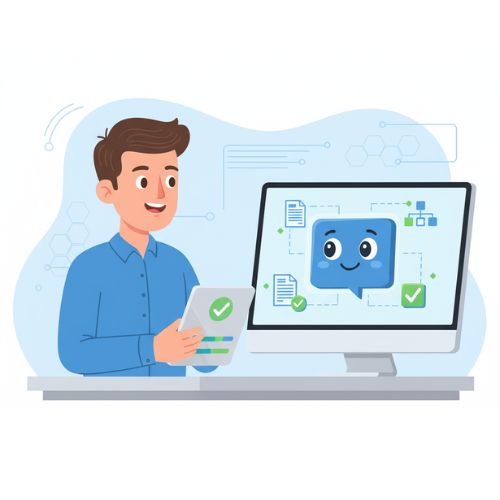From Crawling to Running: A Departmental Guide to Adopting Artificial Intelligence Chatbots in Your Organization
Artificial intelligence (AI) is changing the business landscape, and chatbots are at the forefront. Organizations looking to implement AI chatbots within various departments should start slow (crawl) and gradually introduce new capabilities (walk and run).
In this blog post, we provide a blueprint for the gradual adoption of AI chatbots for Operations, Human Resources, Information Technology, Engineering, Legal, Compliance, Privacy, Sales, Marketing, Procurement, and Quality departments.
1. Operations
Crawl: Begin with automating routine tasks, such as scheduling, reporting, and tracking inventory.
Walk: Enhance the AI chatbot's capabilities to handle more complex processes, such as predicting demand and optimizing supply chain logistics. Train employees to use these tools effectively.
Run: Fully integrate AI chatbots into the operations department, making them a core component of decision-making processes. Continuously improve and evolve the chatbots to adapt to new challenges and opportunities.
2. Human Resources
Crawl: Start by implementing HR chatbots for simple tasks, such as answering employee questions about company policies, benefits, and vacation time. This can reduce the workload on HR staff.
Walk: Expand the chatbot's capabilities to include recruitment and onboarding processes. Automate the screening of resumes and initial interviews, while also providing new employees with orientation materials.
Run: Use AI chatbots to analyze and predict employee performance, satisfaction, and retention. Implement data-driven strategies to improve employee engagement and address potential issues proactively.
3. Information Technology
Crawl: Introduce AI chatbots to assist with basic IT support tasks, such as password resets and troubleshooting common technical issues.
Walk: Enhance the chatbot's capabilities to handle more advanced IT support tasks, such as diagnosing network problems and guiding users through software installations.
Run: Leverage AI chatbots for proactive IT maintenance, including monitoring system performance, identifying potential issues, and optimizing technology infrastructure.
4. Engineering
Crawl: Introduce AI chatbots to assist with basic engineering tasks, such as design reviews, technical documentation management, and answering common engineering-related questions.
Walk: Expand the chatbot's capabilities to handle conducting design simulations, optimizing workflows, and providing preliminary analysis of engineering problems. Train employees to utilize these tools effectively in their daily work.
Run: Fully integrate AI chatbots into the engineering department, allowing them to participate in decision-making processes, offer real-time guidance on complex engineering matters, and continuously learn from the expertise of engineering professionals.
5. Legal
Crawl: Introduce AI chatbots to assist with routine legal tasks, such as contract review and drafting basic legal documents.
Walk: Enhance the chatbot's capabilities to include conducting legal research, identifying relevant case law, and providing preliminary analysis of legal issues.
Run: Fully integrate AI chatbots into the legal department, allowing them to participate in decision-making processes and offer real-time guidance on complex legal matters, while continuously learning from the expertise of legal professionals.
Looking for a smarter way to support your team?
6. Compliance
Crawl: Implement AI chatbots to assist with routine compliance tasks, such as monitoring regulatory changes and ensuring adherence to policies.
Walk: Use chatbots to automate the analysis of data for potential compliance risks, flagging potential issues, and streamlining the reporting process.
Run: Fully integrate AI chatbots into the compliance department, enabling them to actively participate in decision-making processes and provide real-time guidance on complex compliance matters.
7. Privacy
Crawl: Implement AI chatbots to help monitor and ensure compliance with data protection regulations, such as GDPR and CCPA. Start by automating tasks like data inventory management and privacy policy updates.
Walk: Implement chatbots that can assist in conducting data privacy impact assessments and detecting potential privacy risks, allowing the privacy department to address issues proactively.
Run: Leverage AI chatbots to create a culture of privacy within the organization, continuously monitoring data processing activities, and providing real-time guidance on privacy best practices.
8. Sales
Crawl: Begin by using AI chatbots for lead qualification, allowing sales representatives to focus on more promising prospects.
Walk: Expand the chatbot's capabilities to include providing product information, answering customer questions, and scheduling meetings with sales representatives.
Run: Implement AI chatbots to analyze sales data, identify trends, and generate personalized recommendations to boost sales performance.
9. Marketing
Crawl: Start by using AI chatbots for basic marketing tasks, such as social media monitoring, content curation, and customer engagement.
Walk: Enhance the chatbot's capabilities to include more advanced marketing functions, such as personalized content creation, targeted advertising, and customer segmentation. Train employees to leverage these tools for more effective campaigns.
Run: Fully integrate AI chatbots into the marketing department, allowing them to participate in strategic decision-making processes, analyze campaign performance, and provide real-time insights to optimize marketing efforts. Continuously update and improve the chatbots to stay ahead of industry trends and customer preferences.
10. Finance
Crawl: Begin by incorporating AI chatbots for basic finance tasks, such as expense tracking, invoice processing, and answering employee questions about reimbursements.
Walk: Expand the chatbot's capabilities to include more complex finance functions, such as financial analysis, budgeting, and forecasting. Train employees to use these tools effectively to make data-driven decisions.
Run: Fully integrate AI chatbots into the finance department, allowing them to assist in strategic decision-making processes, optimize financial performance, and identify potential risks and opportunities. Continuously improve and evolve the chatbots to adapt to the changing financial landscape.
11. Procurement
Crawl: Begin by implementing AI chatbots for simple procurement tasks, such as supplier research, purchase order management, and tracking of order status. This can help streamline the procurement process.
Walk: Enhance the chatbot's capabilities to include more advanced procurement functions, such as supplier performance monitoring, contract negotiation, and risk assessment. Train employees to leverage these tools for more efficient procurement operations.
Run: Fully integrate AI chatbots into the procurement department, allowing them to assist in strategic decision-making processes, optimize procurement performance, and identify potential risks and opportunities.
12. Quality Assurance
Crawl: Start by using AI chatbots for basic quality assurance tasks, such as defect tracking, test case management, and answering common QA-related questions. This can help reduce manual work for the QA team.
Walk: Expand the chatbot's capabilities to include more complex QA functions, such as automated testing, performance monitoring, and root cause analysis.
Run: Fully integrate AI chatbots into the quality assurance department, allowing them to contribute to strategic decision-making processes, analyze QA data, and provide real-time insights to optimize quality control efforts. Continuously update and improve the chatbots to adapt to the evolving QA landscape and industry standards.
Conclusion
Adopting AI chatbots in a gradual, department-specific manner allows businesses to maximize the benefits of this technology while minimizing potential risks. By following the crawl, walk, run approach, organizations can ensure a smooth transition to AI chatbot adoption, ultimately streamlining operations, enhancing productivity, and driving business growth.
Answers your employees need, right when they need them
Meet Botable — the AI chatbot that handles everything from simple FAQs to complex, multi-step questions, so your team can focus on what matters. Built for HR, QA, and beyond.
Continue reading
Ready to see what Botable can do for you?
Book your demo now to see how Botable can transform your workplace.
Identify your unique challenges
Flexible pricing options
Easy integrations
Step-by-step implementation plan
Customize Botable for your workflow
Book a demo
.webp)









